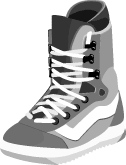Snowboarding Boots

Comfort comes first with snowboarding boots, but everyone wants performance. Learn how to select your boots here.
How To Buy Snowboard Boots
The characteristics of your snowboard boot will have a dramatic effect on your riding experience. The snowboard boot is the only piece of equipment that has direct contact with the rider. First and foremost your boots must be comfortable and work with your particular riding style.
Types of Boots
You have to make sure your boots are compatible with your board and bindings, as well as with the type of riding you plan to do.
Soft Boots
- Technical freestyle, freestyle, and freeride boarders generally prefer soft boots for their comfort and performance
- Soft boots provide support from the rigid structure of the high-back or low-back bindings that you strap the boot into
Hard Boots
- Hard boots resemble traditional ski boots, with a rigid plastic shell
- Hard boots are generally preferred by carving/alpine boarders for their increased ankle support and added control
- Hard boots are not as comfortable as soft boots but the trade-off is in the extra support
Riding Style
Technical Freestyle This type of rider is most often found on the lower elevations of the mountain, hiking the halfpipe or riding in the snowboard park. Many of today's technical freestyle riders come to snowboarding with experience as a skateboarder, in-line skater, BMX, or other action sports background. While the equipment specific to this type of rider excels in park and pipe riding, it can also be very versatile across the whole mountain at less than full-speed.
- Technical freestyle boots
- As with boards, most technical freestyle boots are found at the top of the price list
- They are also the lightest boots and usually incorporate a relatively stiff forward flex with moderate lateral support
- Many manufacturers make these boots in both traditional strap and step-in models
Freeride
Freeride is the best way to describe the majority of snowboarders and soon-to-be snowboarders. As it suggests, freeride describes a user who intends to utilize the whole mountain. These riders enjoy everything about snowboarding: the amazing feel of carving a turn on freshly groomed slopes, the sense of flight obtained at lift-off from the big-air jump, the creativity that can only be understood descending the half-pipe, and the feel of freedom one gets floating in fresh powder.
- Freeride boots
- When choosing a pair of freeride boots, the rider should consider the type of riding they may do most often - halp-pipe, park, powder, groomed or terrain - and tailor their purchase to match their type of riding
- Freeride is also the most compelling segment of the Step-In market, since the fit options are so diverse
Freecarve
This type of riding style is one of the fastest growing segments within the snowboarding world. Commonly referred to as "cross-over," a majority of these riders were once skiers. A freecarve rider enjoys the full-length and width a mountain has to offer, continually transitioning from one turn to the next.
- Freecarve boots
- Most riders who consider themselves freecarvers choose to use freeride boots for their comfort and choice
- The selection of boots that are specific freecarve boots are limited
- However, there are some freecarve specific boots which offer the highest level of support and board feel for the quintessential ride
Alpine/Race
Alpine/Race riders are easily picked out of the crowd. They are always seen on groomed trails, laying a trench in the snow with each turn. These riders use a snowboards edge like no other rider. Using powerful body movements and gravity as their friend, alpine riders enjoy the sport only when they are connected to the snow.
- Alpine/Race boots
- Alpine/Race boots are hard boots
- They are usually a mix of polyurethane,polyethylene, and space age composites
- Many riders actually choose to use traditional hard-shell ski boots
Determining Your Size
- Snowboard boots are sized the same as regular shoes and sneakers; therefore, your shoe size will be the same as your boot size
- The fit of a snowboard boot should be snug and your heel needs to stay in place when flexed, so if you are between sizes go for the smaller size